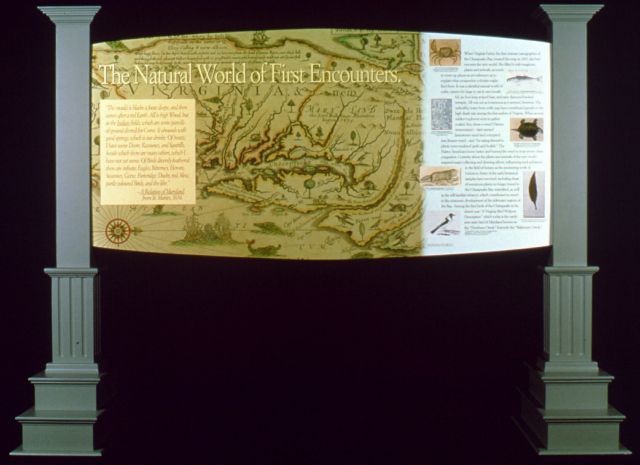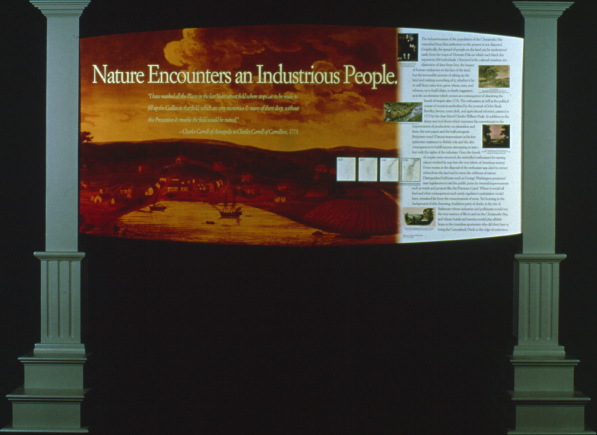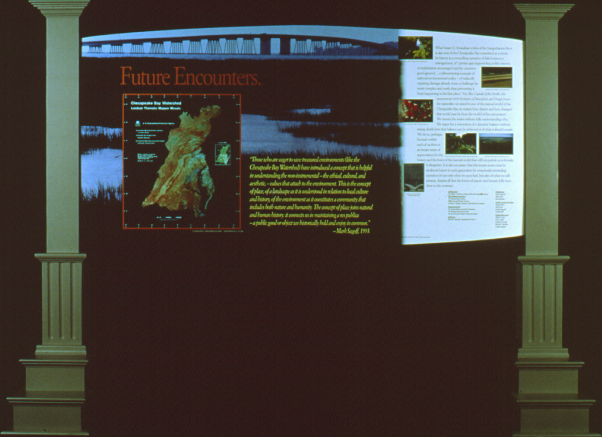The Natural World of Native Americans, Europeans, and Africans, 1560 - 1800


The Chesapeake Bay stretches nearly 200 miles from the mouth of the Susquehanna River to the Atlantic Ocean. Its watershed extends from Cooperstown, New York on the north, to Cape Henry on the south, and to the Appalachian Mountains on the west. Its 8,700 miles of shoreline, 50 islands, and over 40 tributary rivers are home to 2,700 species of plants and animals. In 1990, nearly 15 million people inhabited its 64,000 square miles of watershed. Three million more are expected to live there by the year 2020. What plants and animals will be there to greet them is not nearly as certain.
The interaction between the human population and the natural world profoundly affects both, although in what measure and with what consequences we are only beginning to understand through a multi-discipline probing of the historical and physical record. Archival research in the written and oral evidence of the past, painstaking archaeological exploration of the ground, and careful analysis of the layers of soil in core samples taken in and about the Bay, scientists are beginning to learn what the world of the past was like. By doing, so we not only learn that the canopy of the old growth forest was 40 feet taller than we know it today, but also that we have the unprecedented opportunity of applying such knowledge and understanding as we encounter and attempt to shape the natural world of the future.

The Natural World of First Encounters.
The world of the Chesapeake Bay when Europeans encountered it was a plentiful natural world of crabs, oysters too large to eat in one mouthful, six foot long striped bass, and tasty diamond backed terrapin. All was not as bounteous as it seemed, however. The unhealthy water from wells may have contributed greatly to the high death rate among the first settlers of Virginia. When several soldier/explorers went to gather a salad, they chose a weed (Datura stramonium)- later named Jamestown weed and corrupted into Jimson weed- and "by eating thereof in plenty were rendered apish and foolish." The Native Americans knew better and burned the weed to treat severe chest congestion.
Curiosity about the plants and animals of the new world inspired major collecting and drawing efforts. Some of the early botanical samples have survived, including those of numerous plants no longer found in the watershed, as well as tobacco, which contributed so much to the economic development of the tidewater regions of the Bay. Among the first birds of the Chesapeake to be drawn was "A Virginia Bird Without Description" which today is the rarely seen state bird of Maryland known as the "Northern Oriole," formerly the "Baltimore Oriole."

The Human World of First Encounters
When John Smith first encountered the Susquehannock tribe in the upper Bay he was so impressed with their size that he described them in detail as a 'giant like people.' When Captain Cyprian Thorowgood explored the mouth of the Susquehanna for Lord Baltimore in May of 1634, he too left a terrifying description of the savagery of the natives, including their cannibalism, which he informs the reader he learned from a "Negro who lived among them to learn the language."
There were as many as 45,000 Native Americans living in the Chesapeake Bay area when the Europeans began to arrive. Not all the encounters were fearful and war-like, although the colony at Jamestown came close to extinction more than once at the hands of the native population, and the spread of alien diseases diminished the presence of both natives and immigrants. The new arrivals learned much from their understandably suspicious hosts. The Marylanders bought an abandoned village which they immediately began to Europeanize, making the best use of locally available building materials.
The Europeans learned more than the language, the value of new world crops, and how to fish from the Native Americans, but they also tried to make them over in their own image. Europeans saw what they wanted to see and would not be restrained in taking what they wanted to take. Not all aspirations were realized. When he died in 1624, Edward Palmer, the English landlord of an island at the mouth of the Susquehanna, left instructions that the equivalent of Oxford University be built high upon its hill. Instead, the summit he intended for a place of learning was blasted for a railroad bridge that today carries AMTRAK's main line.

Human Encounters of a Changing Kind
It was the combination of imported labor (first European and then African) and John Rolfe's success in 1612 in producing a milder, better tasting variety of the native grown tobacco that secured the European presence in the Chesapeake, although diseases they encountered and brought with them wreaked considerable havoc and made the early years of settlement a time of trial.
As slavery became less expensive and more attractive than bound labor, the nature and composition of society changed dramatically. Not without a struggle, Native Americans were pushed to the periphery of settlement and only by the sheer force of empire was an often-breached line drawn along the Appalachian Mountains (1763) warning that the lands beyond were not for the taking. As the African American population grew in the context of chattel slavery, society was forced to encounter the meaning and intent of human bondage while adapting and adopting the knowledge the Africans brought with them. Slavery created an unequal society, and tobacco cultivation encouraged the growth of pathogenic organisms in the soil that weakened successive crops.
New voices and tongues were heard as non-English speaking immigrants, particularly from what is now Germany, arrived to help push the bounds of settlement from the Tidewater to the mountains. They brought with them improved methods of farming and diversification of crops as well as differing cultural values and calls for political empowerment that could not be disregarded for long.

Nature Encounters an Industrious People
The industriousness of the population of the Chesapeake Bay watershed from first settlement to the present is not disputed. But the growth in numbers obscures the cultural variation, the distinction of slave from free, the impact of human endeavors on the face of the land. However, the inexorable process of taking up the land and making something of it, whether it be to mill flour, mine iron, grow wheat, corn, and tobacco, or to build ships is clearly suggested, as is the acceleration which occurs as a consequence of dissolving the bonds of empire after 1776.
Once the bonds of empire were removed, the unbridled enthusiasm for taming nature worked its way into the very fabric of American Society. Every means at the disposal of the enthusiast was used to extract riches from the land and to tame the wildness of nature. Distinguished lobbyists such as George Washington pressured state legislatures to raid the public purse for internal improvements such as roads and projects like the Potomac Canal. Where it would all lead and what consequences such rarely regulated exploitation would have remained far from the consciousness of most.

Future Encounters.
What Susan Q. Stranahan writes of the Susquehanna River is also true of the Chesapeake Bay watershed as a whole. Its history is a compelling narrative of failed resource management, of "private gain superseding public interest, of exploitation encouraged and the common good ignored, ... a disheartening example of national environmental policy-- of belatedly repairing damage already done, a challenge far more complex and costly than preventing it from happening in the first place." Yet like Captain John Smith, the anonymous 1634 Relation of Maryland, and Hugh Jones the naturalist, we stand in awe of the natural world of the Chesapeake Bay no matter how distant and how changed that world may be from the world of first encounters. We mourn the losses without fully understanding why. We argue for a restoration of a dynamic balance without seeing clearly how that balance can be achieved or of what it should consist. We do so, perhaps, because within each of us there is an innate sense of appreciation for the beauty and the force of the natural world that will not permit us to forsake it altogether. It is also necessary that this innate sense must be awakened anew each generation by consciously reminding ourselves of not only what we once had, but also of what we still possess, despite all that the forces of nature and human folly have done to the contrary.

Cities and the Wilderness: Slow Birth, Profound Consequences
Probably no single presence on the bay affected its history more than Baltimore, yet for nearly a century of settlement no such place took root. Indeed the odds were against a thriving urban center on the shores of the Chesapeake Bay until there was an urgent need for a collection and distribution center for goods and services during the American Revolution. Then the inertia of urban growth came with a vengeance to the upper Bay. Until then the little hamlet on the Patapsco, begun in the 1730s, struggled to make itself heard in stiff competition with Annapolis, its small, politically powerful rival 30 miles to the South where government provided the chief source of entertainment and motivation for decidedly limited growth.